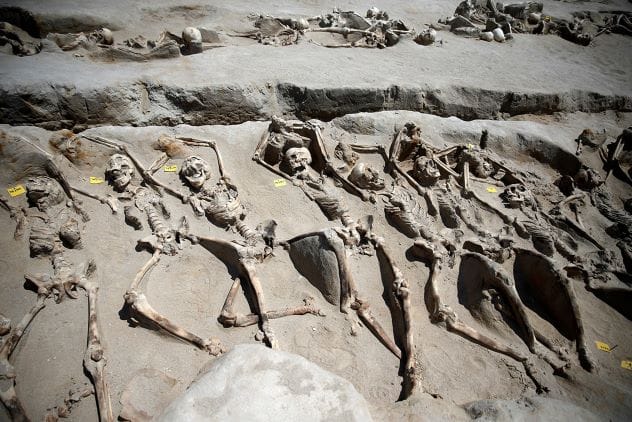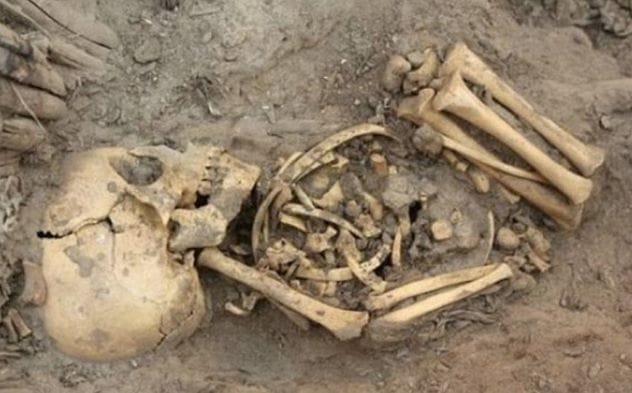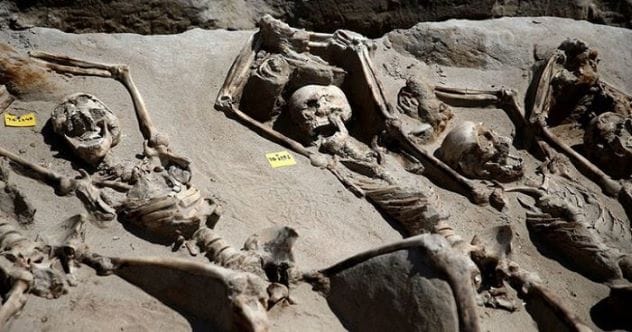It’s almost Halloween, the perfect time to delve into the eerie and macabre. What better way to embrace the season than by exploring some of the most disturbing burial sites unearthed from the past?
Join us as we journey to forgotten resting places, where the bones tell tales of vampires, witches, gladiators, and unimaginable horrors. Prepare yourself for a chilling exploration of history’s darkest corners!
10. Mass Grave of Shackled Young Men

In 2016, archaeologists uncovered a grim scene in the Falyron Delta Necropolis, an ancient Greek graveyard. Eighty skeletons, many with their jaws agape as if in a final scream, were found shackled. These young men, who died between 650 and 625 BC from blows to the head, are believed to be supporters of Cylon, an Athenian noble who failed to overthrow the Archons of Athens in 632 BC. Their orderly burial suggests a degree of respect, despite their failed revolt.
9. Vampire Burials in Bulgaria
Bulgaria is home to around 100 vampire burial sites, a testament to the widespread vampire superstitions in the Balkans during the Middle Ages. To prevent the deceased from rising, people took extreme measures. One man in Perperikon was found with an iron pole through his chest and a severed leg placed beside him. Krivich, a fortress leader, suffered a similar fate, with an iron bar piercing his chest to ensure he remained dead, solidifying Bulgaria’s place as the land of real vampire legends.
8. Remains of 100 Dead Babies

In 1988, a sewer beneath a Roman bathhouse in Ashkelon, Israel, revealed a heartbreaking discovery: the remains of around 100 infants. These newborns, all under a week old and seemingly healthy at the time of their deaths, were discarded without a second thought. DNA testing indicated most were males, leading to theories about unwanted children born to prostitutes at the bathhouse. In Roman times, babies weren’t fully recognized as human until a naming ceremony, contributing to this horrifying practice.
7. Slaughter Pit at Sacred Ridge
At Sacred Ridge, a Native American settlement in Colorado, archaeologists found a gruesome scene of scattered human remains within 22 pit homes. Around 1,200 years ago, approximately 35 residents were hobbled, beaten, scalped, and dismembered, with double-headed axes nearby indicating the cause. It’s believed that neighboring villagers carried out this massacre due to the settlement’s lower status and potential witchcraft practices, crushing heels and toes to prevent escape and ward off evil spirits.
6. Human Petrifaction
Girolamo Segato, an Italian who traveled to Egypt in the 1820s, became obsessed with mummification and developed his own petrifaction process to mineralize human remains, preserving their original color and elasticity. He secretly obtained bodies through grave-robbing to perfect his technique. Segato’s preserved works can be seen at the University of Florence, including a table made of petrified human organs gifted to Grand Duke Ferdinand III. Segato’s tomb says, “Here lies decayed Girolamo Segato…who could have been totally petrified if his art had not died with him.”
5. The Underground Labyrinth of Death
In Peru, archaeologists discovered a labyrinth of 36 underground passages beneath a 3,000-year-old temple at Chavin de Huantar using remote-operated robots. Within these dark tunnels lay the intact remains of three people, likely sacrificed in rituals involving drugs, noise, and light manipulation. Buried face down among the rocks in simple cotton clothes, these individuals were deemed of lower social status. The tombs also contained precious metals, colorful textiles, and other valuable historical artifacts, painting a vivid picture of ancient ceremonial practices.
4. Pits Full of Heads
Near the Great Wall of China, archaeologists uncovered evidence of the Shimao nation, an early society that practiced human sacrifice. Six pits filled with the beheaded remains of young women were discovered at the site. These heads were found in a massive pyramid and were used as offerings to the gods for good fortune in building their site. The pyramid, 70 meters tall, housed the Shimao rulers and elite, serving as a reminder of the social hierarchy of the time.
3. Beheaded Gladiators
In York, England, archaeologists discovered the beheaded corpses of tall men, possibly Retiarii gladiators who fought with nets and lances. These skeletons, dating from the second to fourth centuries A.D., were decapitated, with their heads placed on their chests, between their legs, or even between their feet. The skeletons showed signs of trauma, suggesting they were either gladiators, military men, or criminals forced to fight for sport. The true origins of these remains continue to be a mystery.
2. Toothy Tumor

Spanish archaeologists examining the 1,600-year-old skeleton of a Roman woman found a calcified ball of bone containing four twisted teeth in her hips. This ovarian teratoma, a tumor emerging from germ cells, is the first such medical condition found in ancient remains. Found in a simple grave, the woman was of low social class. While this tumor might have been asymptomatic, it could have caused her death by displacing organs, leading to infection, anemia, or pregnancy complications, shocking archaeologists with its alien-like appearance.
1. Remnants of a Witch Chase
In Aberdeen, Scotland, a fifteenth-century church contains a grim reminder of the “Great Witch Hunt” of 1597. A stone column with an iron ring was used to restrain accused witches. During this period, around 400 individuals were tried, and roughly 200 were executed through drowning, burning, and beheading. One notable case is that of Jane Wishart, accused of 18 points of witchcraft, and her son Thomas Leyis. Both were strangled and burned, marking a dark chapter in Aberdeen’s history.
These burial sites offer haunting glimpses into the past, revealing the diverse and often disturbing ways humans have dealt with death, superstition, and societal conflict. From shackled skeletons to vampire graves and ritual sacrifices, each site tells a unique and unsettling story. As we reflect on these discoveries, we gain a deeper understanding of our shared history and the enduring mysteries that lie beneath the surface.
What did you think about these creepy sites? Leave your comment below!









